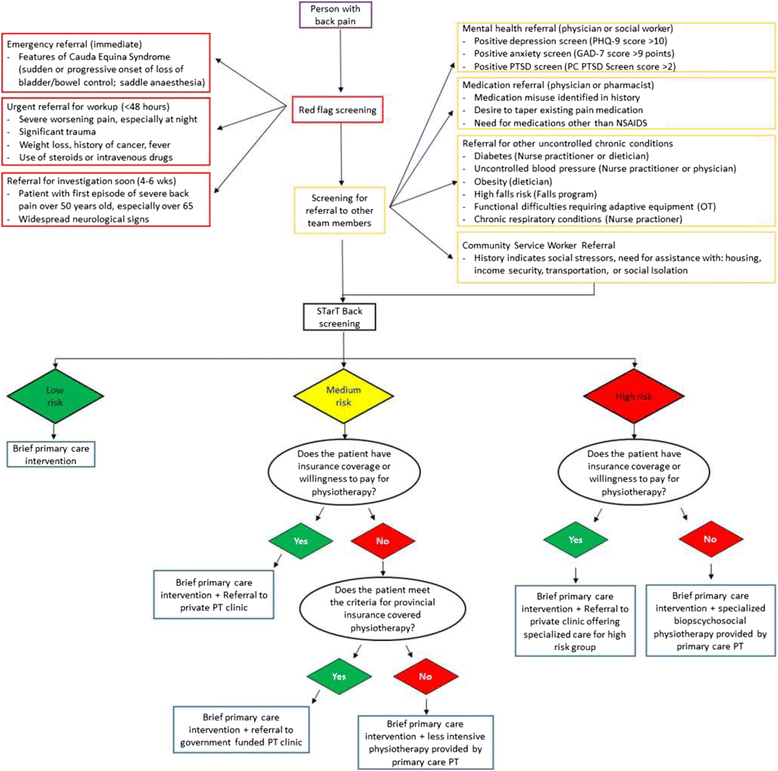Determining the impact of a new physiotherapist-led primary care model for back pain: protocol for a pilot cluster randomized controlled trial
- PMID: 29121989
- PMCID: PMC5680754
- DOI: 10.1186/s13063-017-2279-7
Determining the impact of a new physiotherapist-led primary care model for back pain: protocol for a pilot cluster randomized controlled trial
Abstract
Background: Back pain is a leading contributor to disability, healthcare costs, and lost work. Family physicians are the most common first point of contact in the healthcare system for people with back pain, but physiotherapists (PTs) may be able to support the primary care team through evidence-based primary care. A cluster randomized trial is needed to determine the clinical, health system, and societal impact of a primary care model that integrates physiotherapists at the first visit for people with back pain. Prior to conducting a future fully powered cluster randomized trial, we need to demonstrate feasibility of the methods. Therefore, the purpose of this pilot study will be to: 1) Determine feasibility of patient recruitment, assessment procedures, and retention. 2) Determine the feasibility of training and implementation of a new PT-led primary care model for low back pain (LBP) 3) Explore the perspectives of patients and healthcare providers (HCPs) related to their experiences and attitudes towards the new service delivery model, barriers/facilitators to implementation, perceived satisfaction, perceived value, and impact on clinic processes and patient outcomes.
Methods: This pilot cluster randomized controlled trial will enroll four sites and randomize them to implement a new PT-led primary care model for back pain or a usual physician-led primary care model. All adults booking a primary care visit for back pain will be invited to participate. Feasibility outcomes will include: recruitment and retention rates, completeness of assessment data, PT training participation and confidence after training, and PT treatment fidelity. Secondary outcomes will include the clinical, health system, cost, and process outcomes planned for the future fully powered cluster trial. Results will be analyzed and reported descriptively and qualitatively. To explore perspectives of both HCPs and patients, we will conduct semi-structured qualitative interviews with patients and focus groups with HCPs from participants in the PT-led primary care sites.
Discussion: If this pilot demonstrates feasibility, a fully powered trial will provide evidence that has the potential to transform primary care for back pain. The full trial will inform future service design, whether these models should be more widely implemented, and training agendas.
Trial registration: ClinicalTrials.gov, NCT03320148 . Submitted for registration on 17 September 2017.
Keywords: Cluster randomized trial; Low back pain; Physiotherapy; Primary care.
Conflict of interest statement
Ethics approval and consent to participate
Ethics approval for this protocol has been obtained from the Queen’s University Health Science and Affiliated Teaching Hospitals Research Ethics Board (HSREB #6021536).
Consent for publication
Not applicable.
Competing interests
The authors declare that they have no competing interests.
Publisher’s note
Springer Nature remains neutral with regard to jurisdictional claims in published maps and institutional affiliations.
Figures


Similar articles
-
The Fear Reduction Exercised Early (FREE) approach to low back pain: study protocol for a randomised controlled trial.Trials. 2017 Oct 17;18(1):484. doi: 10.1186/s13063-017-2225-8. Trials. 2017. PMID: 29041947 Free PMC article. Clinical Trial.
-
Implementing a new physiotherapist-led primary care model for low back pain: a qualitative study of patient and primary care team perspectives.BMC Prim Care. 2022 Aug 11;23(1):201. doi: 10.1186/s12875-022-01817-5. BMC Prim Care. 2022. PMID: 35948876 Free PMC article.
-
Independent prescribing by advanced physiotherapists for patients with low back pain in primary care: protocol for a feasibility trial with an embedded qualitative component.BMJ Open. 2019 May 1;9(4):e027745. doi: 10.1136/bmjopen-2018-027745. BMJ Open. 2019. PMID: 31048447 Free PMC article.
-
Development and implementation of a nurse-led allergy clinic model in primary care: feasibility trial protocol.NPJ Prim Care Respir Med. 2019 Dec 6;29(1):44. doi: 10.1038/s41533-019-0155-5. NPJ Prim Care Respir Med. 2019. PMID: 31811151 Free PMC article. Review.
-
The impact of direct access physiotherapy compared to primary care physician led usual care for patients with musculoskeletal disorders: a systematic review of the literature.Disabil Rehabil. 2021 Jun;43(12):1637-1648. doi: 10.1080/09638288.2019.1674388. Epub 2019 Oct 11. Disabil Rehabil. 2021. PMID: 31603709
Cited by
-
Delivering Team-Based Primary Care for the Management of Chronic Low Back Pain: An Interpretive Description Qualitative Study of Healthcare Provider Perspectives.Can J Pain. 2023 Sep 8;7(1):2226719. doi: 10.1080/24740527.2023.2226719. eCollection 2023. Can J Pain. 2023. PMID: 37701549 Free PMC article.
-
Self-reported use of family physician, chiropractor and physiotherapy services among adult Canadians with chronic back disorders: an observational study.BMC Health Serv Res. 2018 Dec 17;18(1):970. doi: 10.1186/s12913-018-3790-6. BMC Health Serv Res. 2018. PMID: 30558605 Free PMC article.
-
"It feels like an endless fight": a qualitative study exploring healthcare utilization of persons with rheumatic conditions waiting for pain clinic admission.BMC Musculoskelet Disord. 2022 Sep 22;23(1):878. doi: 10.1186/s12891-022-05808-6. BMC Musculoskelet Disord. 2022. PMID: 36131335 Free PMC article.
-
Physiotherapy Practice in Primary Health Care: A Survey of Physiotherapists in Team-Based Primary Care Organizations in Ontario.Physiother Can. 2022 Jan 1;74(1):86-94. doi: 10.3138/ptc-2020-0060. Epub 2021 Feb 23. Physiother Can. 2022. PMID: 35185252 Free PMC article.
-
Clinician's Commentary on Vader et al.1.Physiother Can. 2022 Jan 1;74(1):95-96. doi: 10.3138/ptc-2020-0060-cc. Epub 2022 Jan 31. Physiother Can. 2022. PMID: 35185253 Free PMC article. No abstract available.
References
-
- Bone and Joint Canada . Low back pain. 2014; epidemiology of low back pain. 2016.
-
- Katz JN. Lumbar disc disorders and low-back pain: socioeconomic factors and consequences. J Bone Joint Surg Am. 2006;88(Suppl 2):21–4. - PubMed
-
- Singer J. A snapshot of health care in Canada as demonstrated by top 10 lists, 2011. Toronto: Canadian Institute of Health Information; 2011. Available from: http://www.health.gov.on.ca/en/pro/programs/ohip/sob/physserv/sob_master.... Accessed 15 Sept 2017.
Publication types
MeSH terms
Associated data
LinkOut - more resources
Full Text Sources
Other Literature Sources
Medical
Miscellaneous

